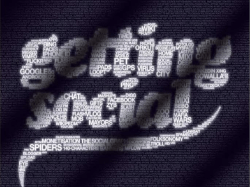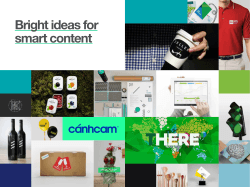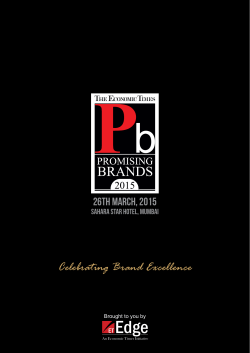
WAGGENER EDSTROM`S BRAND AGILITY INDEX AT
WAGGENER EDSTROM’S BRAND AGILITY INDEX AT Mobile World Congress is billed as one Below are our four key takeout’s from the noise of the most important weeks for the generated at MWC. telecoms industry and this year’s event was no exception. 1. POSITIVE HYPE DOESN’T ALWAYS LEAD TO POSITIVE REACTIONS SO BE READY TO ENGAGE Samsung planned on launching its WITH NAYSAYERS AFTER LAUNCH Galaxy S6, HTC’s Vive would show how HTC’s entry into the Virtual Reality market was truly immersive it is, while analysts were one of the most anticipated and surprising expecting big things from Facebook’s products receiving over 3,000 mentions on Mark Zuckerberg’s keynote. But, Twitter a week before it was officially released. which brands were most successful The product was universally well received, at communicating its messages? winning TechRadar’s Best in Show award. Not those you’d expect according Conversely, Samsung’s S6 was glorified even to our Brand Agility Index (BAI). more than the Vive, receiving 18,000 mentions on the eve of the event but still received Waggener Edstrom (WE) analysed mixed reviews. the top brands and several upand-comers at #MWC2015 using What could HTC and Samsung have done our bespoke Brand Agility Index differently? measurement tool to find out. HTC learnt from previous MWC mistakes by WE’s BAI scores brands’ social bringing something new to the table beyond interactions on 10 metrics the ‘standard’ handset announcement (HTC including: speed, sentiment, One M9). The brand played a smart game business impact, standout and across owned and earned media by putting originality. the tech into the hands of as many journalists as possible. With so many people commenting Overall, Twitter was key for online about the products performance, driving conversations with 90% including numerous comparisons to the of MWC2015 mentions coming Oculus Rift, the brand didn’t need to have from the micro-blogging site alone. an aggressive presence on social media as lamented the lack of a water-resistance journalists and consumers were doing it for feature. As a result of poor sentiment, them. Of course it wasn’t all about Virtual Samsung’s overall Brand Agility score was Reality, HTC did a fantastic job of promoting just 38. the positively received HTC One M9 with #htconelife receiving 39 million impressions 2. CHOOSING THE RIGHT PLATFORM FOR YOUR and #htconem9 receiving 43 million CONTENT IS KEY impressions – one of the most shared hashtags Ikea, a non-telecoms player, could have from the event. As a result HTC won our Brand launched its phone-charging furniture at any Agility Index for the second year in a row trade show, but took a gamble and decided scoring 46. on MWC. With a weak battery life being a massive bug-bear for many smartphone users, Samsung on the other hand, suffered because its charging devices sent Twitter users into a of low sentiment. In the same way the City frenzy. The campaign scored well for standout, responds to quarterly profit statements originality and sentiment finishing third with 41. from corporates, so MWC responds to Vodafone on the other hand had the perfect new announcements from brands: for the platform to engage its audience, but did little corporates, the response is based not on an to create any buzz around the event. Aside actual number, but on the actual number’s from mundane tweets, the brand did not tailor relationship to the anticipated number; so its content correctly and scored low points for brands at MWC, the response isn’t based in differentiation, standout, engagement on the actual product spec, but on the and sentiment. It could have done better relationship between the actual and the by actively responding to the themes of the anticipated product spec. show which would have increased its score for speed and engagement. Vodafone finished in Despite the levels of hype hitting fever pitch, last place with 26 points. the Galaxy S6 was seen more as a direct response to Apple’s iPhone 6 rather than a If you want to set social media alight, you handset at the forefront of innovation; it didn’t need to listen more of what your audience add enough technological advances to wants. With so much talk taking place in the set the phone apart. In addition, Samsung’s months leading up to MWC, brands should use decision to lose the removable battery did this data to finesse and adapt their activation not sit well with consumers and journalists plans. What could these brands have done Xiaomi’s minimalist approach with the launch differently? of its cheap Go Pro competitor helped If you want to set social media alight, you it achieve strong levels of sentiment and need to listen more of what your audience engagement. Combined with the speed in wants. With so much talk taking place in the which it engaged fans and followers, saw it months leading up to MWC, brands should use just miss out on third place. this data to finesse and adapt their activation plans. Facebook’s Internet.org initiative is It will be interesting to see if the Chinese important and the story needs to be told but, brands can build on their success next year. with MWC evolving into an event that is more Lenovo, however, tried to do too much about the greatest technologies vs. discussions too quickly and the quality of its campaign around social altruism, it was not the right suffered. Even a large number of different platform for Facebook’s chosen topic. product launches couldn’t help ignite the levels of dialogue seen with other brands’ 3. SPEED AND QUALITY IS KEY launches at MWC. A content partnership Huawei (44) and Xiaomi (40) both scored with Motorola also failed to generate any better than expected thanks to their sharp, excitement leaving the brand score low slick and well executed campaigns. They in differentiation, standout and sentiment. both showed that a speedy digital presence A YouTube video demonstrating one of its doesn’t have to be rushed and that even the products received a dismal few hundred best laid plans can be executed well. views as it was so poorly promoted and consequently finished on 30 points. Huawei’s first smartwatch was a surprise hit of the show - its use of social to accompany the What could these brands have done launch combined paid, earned and owned differently? media successfully. Through the use of the Being a well-known brand will always help #inspiredexperiences hashtag and universal gain instant recognition and engagement, critical acclaim for its new wearable, it owned but at MWC you need to go one step further. much of the conversations taking place on Brands need to put more effort into the ‘show’ Twitter. This helped the brand score top marks and if they come to the table empty handed, in engagement, standout, originality, creativity they should expect to get a similar response. and sentiment. 4. SMALLER BRANDS MUST BE PRO-ACTIVE Smaller brands, such as FitBit and Data Fox, may have relatively low brand awareness, but this didn’t stop them from scoring well for sentiment and reaction. It showed that a pro-active presence can help smaller brands have a positive effect, scoring 31 and 25 respectively. Datafox pushed out lots of creative content relating to MWC and its personalised content made it stand-out amongst the small brands. FitBit received lots of media coverage following the launch of its multi device support but lost points due to its lack of active presence on social media. What could these brands have done differently? Not every brand has big budgets to make a massive impact, but our BAI has shown that you can still succeed, you just need the right strategy. Datafox did well because it spent the time personalising its content to the needs of its audience. As a result, they saw better take up and engagement that many of the bigger players didn’t. In comparison, FitBit came to the event with their brand awareness at an all-time high. However, despite such strong recognition, they didn’t maintain the audiences’ engagement and over time, attendees simply forgot they were there.
© Copyright 2025










